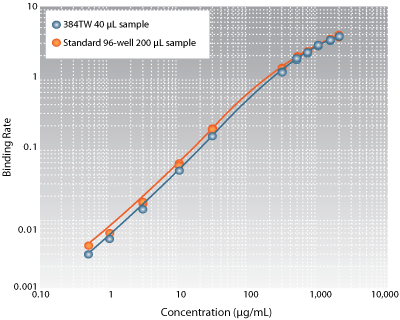For Low Volume, High Sensitivity Assays
The 384TW microplate is a black, polypropylene, 384-well tilted-bottom plate designed for the Octet® family of instruments. It can be used on the Octet RED384, Octet QK384 and Octet HTX instruments accommodate the 384-microwell plate format. The 384TW microplate enables use of samples as small as 40 µL in Octet assays and reduces background signal variability, thus improving assay sensitivity — a particularly beneficial feature for peptide, small molecule and fragment analysis.
Figure 1 and Table 1 show results from a Protein A biosensor-based quantitation assay to detect human IgG (hIgG) in solution. The assay was run on an Octet RED384 system using the standard Basic Quantitation settings with Regeneration module, available in the Octet Data Acquisition software. A comparison of the data obtained in a 96-well flat-bottom microplate using 200 µL of sample to that obtained in a 384TW microplate using only 40 µL of sample shows that assay performance is equivalent in both microplates.
 |
Figure 1: Calibration curve across the dynamic range of 0.5–2000 µg/mL hIgG; results from 384TW microplates compares very well to those from standard flat-bottom 96-well microplates. |
| Test Concentrations
| Measured Avg. Concentrations (µg/mL) |
Percent CV |
| 96-well |
384TW |
96-well |
384TW |
| 2000 |
2000.00 |
1999.98 |
12% |
7% |
| 1500 |
1508.78 |
1503.58 |
7% |
3% |
| 1000 |
1015.90 |
1007.08 |
7% |
4% |
| 700 |
700.20 |
700.70 |
2% |
3% |
| 500 |
503.03 |
502.53 |
3% |
4% |
| 300 |
300.50 |
300.88 |
2% |
3% |
| 30 |
30.10 |
20.05 |
3% |
3% |
| 10 |
10.01 |
10.00 |
3% |
3% |
| 3 |
3.00 |
3.00 |
3% |
3% |
| 1 |
1.00 |
1.00 |
1% |
6% |
| 0.5 |
0.50 |
0.51 |
4% |
9% |
|
Table 1: Measured concentrations and CVs show good dynamic range, recovery and precision in the 384TW microplate vs. a standard 96-well microplate. |
In high-sensitivity screening and kinetic applications, the limit of detection is often defined as 3 times the standard deviation of the baseline signal. The 384TW microplate decreases system artifacts decreasing the variation (and thus the standard deviation) of the baseline signal, allowing smaller signals to be resolved from baseline noise.
The following table contains data obtained on an Octet RED384 system using Super Streptavidin (SSA) biosensors. It includes the average signal and standard deviation of the baseline of these biosensors. The averages and standard deviations for each data point are calculated from 1920 replicates. The lower limit of detection shown is defined as 3 times the standard deviation over the average baseline. For many screening campaigns, this value defines the smallest signal contribution by a positive binding sample. In this experiment the 384TW microplate was found to be advantageous, having a 2-fold lower limit of detection than a standard 384-well flat-bottom plate.
| |
384-Well
Flat-Bottom
Microplate |
384-Well
Tilted-Bottom
Microplate |
| Baseline signal average (PBS) |
-4.8 pm |
-2.0 pm |
| Baseline signal standard deviation |
10.4 pm |
4.3 pm |
| Lower limit of signal detection |
26.4 pm |
10.9 pm |
|
Table 2: 384TW data for Super Streptavidin biosensors on an Octet RED384 system. The data shows a better than 2-fold improvement in detection limit in the 384TW microplate. |
To learn more about the 384TW microplate, download the
. To request a quote, please visit our Ordering page.